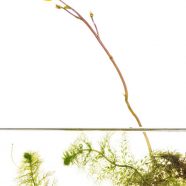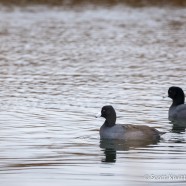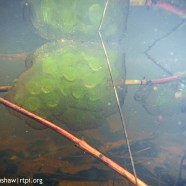Humped Bladderwort (Utricularia macrorhiza)
Gorgeous above the water surface, deadly below it – the Humped Bladderwort (Utricularia macrorhiza), and other bladderworts, use small submerged vesicles – bladders – to trap and digest small aquatic invertebrates to augment their nutrient intake in the wetlands they occupy. These are among the very few carnivorous plants found in the northeastern United States. Photographed by RTPI President Twan Leenders for the Roger Tory Peterson Institute of Natural History and the Meet Your Neighbours global biodiversity project.
Read MoreAmerican Coots
A species such as these American Coot (Fulica americana) entered January finally having to find some open water as the freezing line has penetrated regions like Chautauqua County, quickly locking up the open water of small ponds and waterways. While Lake Erie can still provide a comfortable spot for many waterfowl this winter others will migrate south to the Atlantic Coast and warmer shoreline quarters. These American Coots are actually in the rail family and more closely related to Sandhill Cranes than their duck friends, and if you have ever seen their legs and feet out of the water then...
Read MoreWater Chestnut Infestation
Last week while I was traveling to Connecticut and Rhode Island (I’ll be posting about this soon!), I had the opportunity to get a good look at the Hudson River in eastern New York and see first hand the water chestnut infestation that has taken over much of the waterway. When most people hear of water chestnut, they often think of the slices of white vegetables in your stir fry mix or chicken noodle soup. While that is indeed water chestnut, its not the kind that we are necessarily concerned about. Water chestnut (Trapa natans) is an aquatic plant native to western Europe, Africa and...
Read MoreChasing Hellbenders
It’s a beautiful sunny morning when I join biologists, students and techs from the University of Buffalo and NYS DEC to evaluate a stream for a particularly unique species of amphibian. We dawn our waders and lug our equipment to the water’s edge. The water is still relatively cool and is rolling over the rocky bottom of the river in which we enter. With nets in hand and special poles used to lift large rocks, we begin to evaluate the stream bottom for suitable places a secretive salamander might live. As we find a massive rock along the river floor, we surround it as it is...
Read MoreBouncing Babies
Here we have some bouncing baby…umm, boys and girls I would guess. These spotted salamander (Ambystoma maculatum) babies will soon be hatching from their globular masses and become veracious predators in the little vernal pools in which they temporarily reside. As they feed and grow, they will be racing against the clock in order to develop from free swimming legless tadpoles into four legged land dwellers before their nursery pool dries out towards the end of the summer. Talk about rapid development! Elyse Henshaw Conservation Technician
Read More








